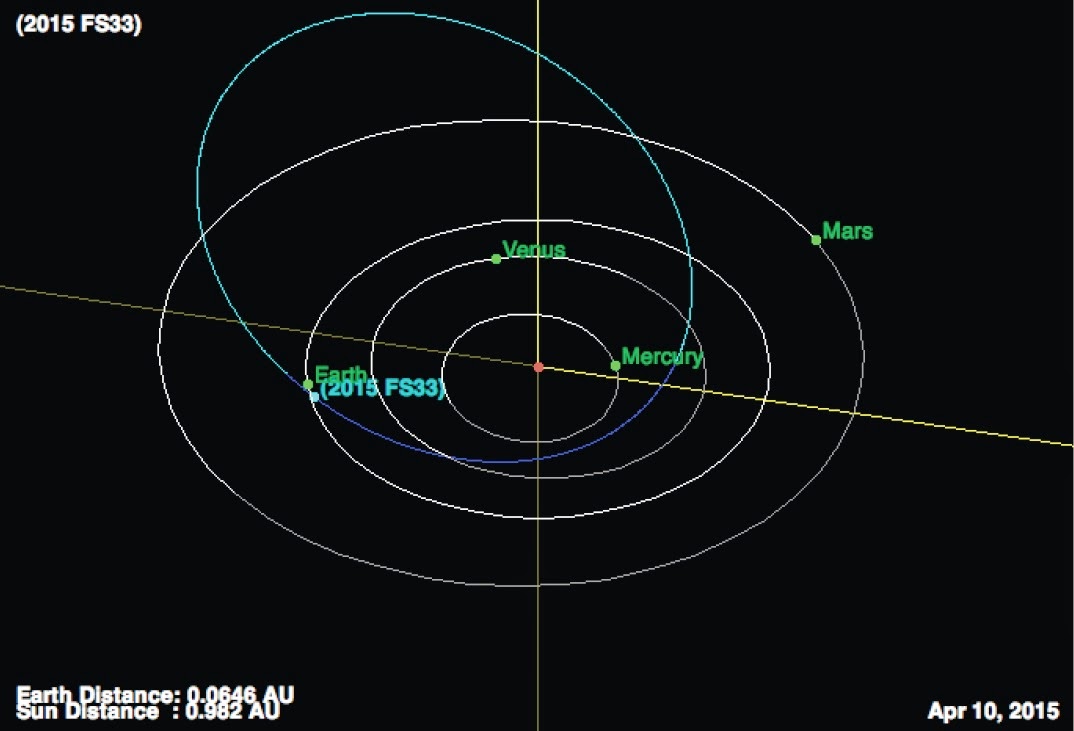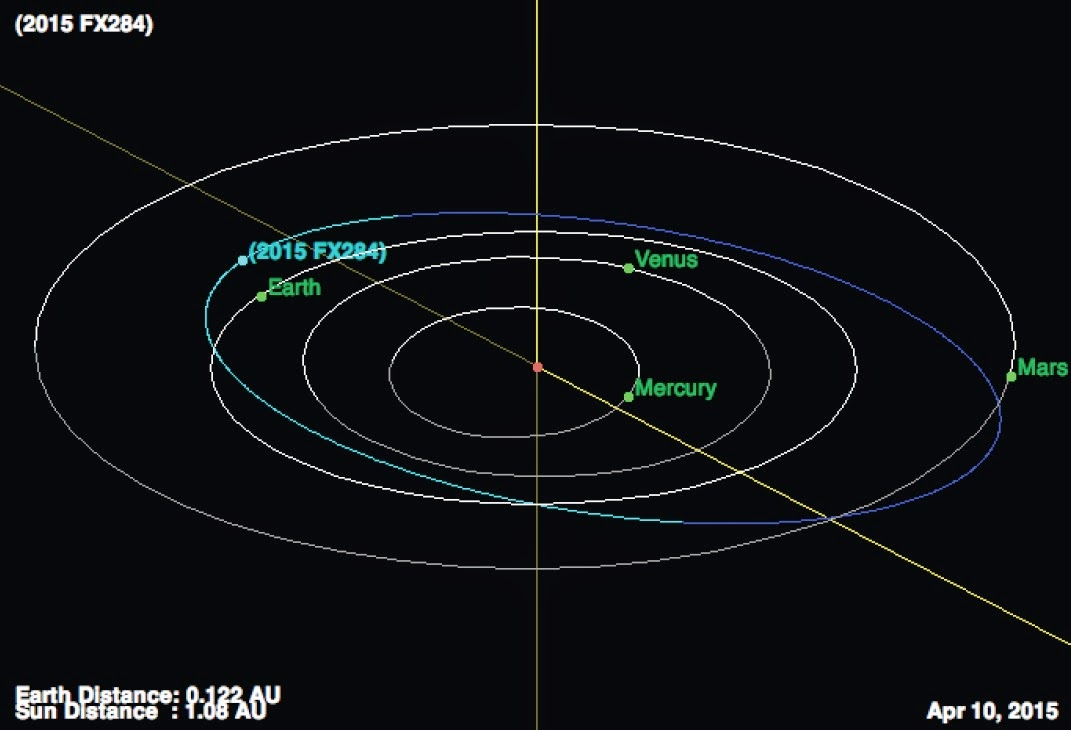Asteroid 2015 FL passed by the Earth at a distance of 7 597
000 km (19.8 times the average distance between the Earth and the Moon,
or 5.08 % of the average distance between the Earth and the Sun), at about 0.50 am GMT on Saturday 11 April 2015. There was no
danger of the asteroid hitting us, though had it done so it would have
presented a genuine threat. 2015 FL has an estimated
equivalent diameter of 130-410 m (i.e. it is estimated that a spherical
object with the same volume would be 130-410 m in diameter), and an
object of this size would pass through the atmosphere and directly
impact the ground with a force of about 65-3000 megatons (roughly 3800-175 000 times the explosive energy of the Hiroshima bomb),
causing devastation over a wide area and creating a crater 2-6
kilometers across, and resulting in global climatic problems that could
last for years or possibly decades.
The calculated orbit of 2015 FL. JPL Small Body Database.
2015 FL was discovered on 16 March 2015 (31 days before its closest approach to the Earth) by the University of Hawaii's PANSTARRS telescope
on Mount Haleakala on Maui. The designation 2015 FL implies that it
was the eleventh asteroid (asteroid L) discovered in the second half of
March 2015 (period 2015 F).
2015 FL has
an 1606 day orbital period and an eccentric orbit tilted at an angle of
15.7° to the plane of the Solar System, which takes it from 0.94 AU from
the Sun (i.e. 94% of the average distance at which the Earth orbits
the Sun) to 4.43 AU from the Sun
(i.e. 443% of the average distance at
which the Earth orbits the Sun, nearly three times the distance at
which the planet Mars orbits the Sun). It is therefore classed as an
Apollo Group Asteroid (an asteroid that is on average further from the
Sun than the Earth, but which does get closer). This means that while close encounters between 2015 FL and the Earth are rare, it does have fairly frequent close encounters with Jupiter, with the last having occured in April 2012 and the next predicted for September 2047.
See also...
 Asteroid 2015 FS33 passes the Earth. Asteroid 2015 FS33 passed by the Earth at a distance of 9 377
000 km (24.4 times the average distance between the Earth and the Moon,
or 6.27 % of the average distance between the Earth and the Sun),
slightly before 8.00 pm GMT on Wednesday 8 April 2015. There was no
danger of...
Asteroid 2015 FS33 passes the Earth. Asteroid 2015 FS33 passed by the Earth at a distance of 9 377
000 km (24.4 times the average distance between the Earth and the Moon,
or 6.27 % of the average distance between the Earth and the Sun),
slightly before 8.00 pm GMT on Wednesday 8 April 2015. There was no
danger of... Asteroid 2015 FX284 passes the Earth. Asteroid
2015 FX284 passed by the Earth at a distance of 18 250 000 km (47.5
times
the average distance between the Earth and the Moon, or 12.2% of the
average distance between the Earth and the Sun), slightly after 10.40 pm
GMT on Tuesday 7 April...
Asteroid 2015 FX284 passes the Earth. Asteroid
2015 FX284 passed by the Earth at a distance of 18 250 000 km (47.5
times
the average distance between the Earth and the Moon, or 12.2% of the
average distance between the Earth and the Sun), slightly after 10.40 pm
GMT on Tuesday 7 April... Comet C/2012 F3 (PANSTARRS) reaches its perihelion. Comet
C/2012 F3 (PANSTARRS) reached its perihelion (the closest point on its
orbit to the Sun) on Tuesday 7 March 2015, when it was 3.46 AU from the
Sun (i.e. 3.46 times the average distance at which the Earth orbits the
Sun). The comet is visible only with a...
Comet C/2012 F3 (PANSTARRS) reaches its perihelion. Comet
C/2012 F3 (PANSTARRS) reached its perihelion (the closest point on its
orbit to the Sun) on Tuesday 7 March 2015, when it was 3.46 AU from the
Sun (i.e. 3.46 times the average distance at which the Earth orbits the
Sun). The comet is visible only with a...
Follow Sciency Thoughts on Facebook.

